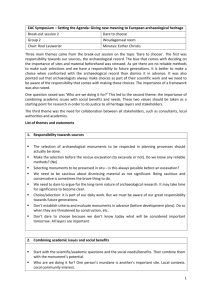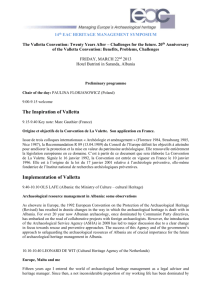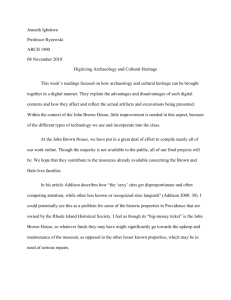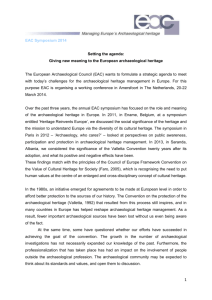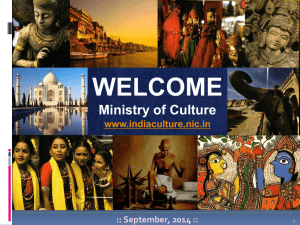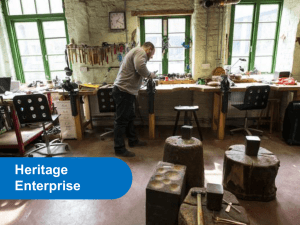14th EAC HERITAGE MANAGEMENT SYMPOSIUM
advertisement
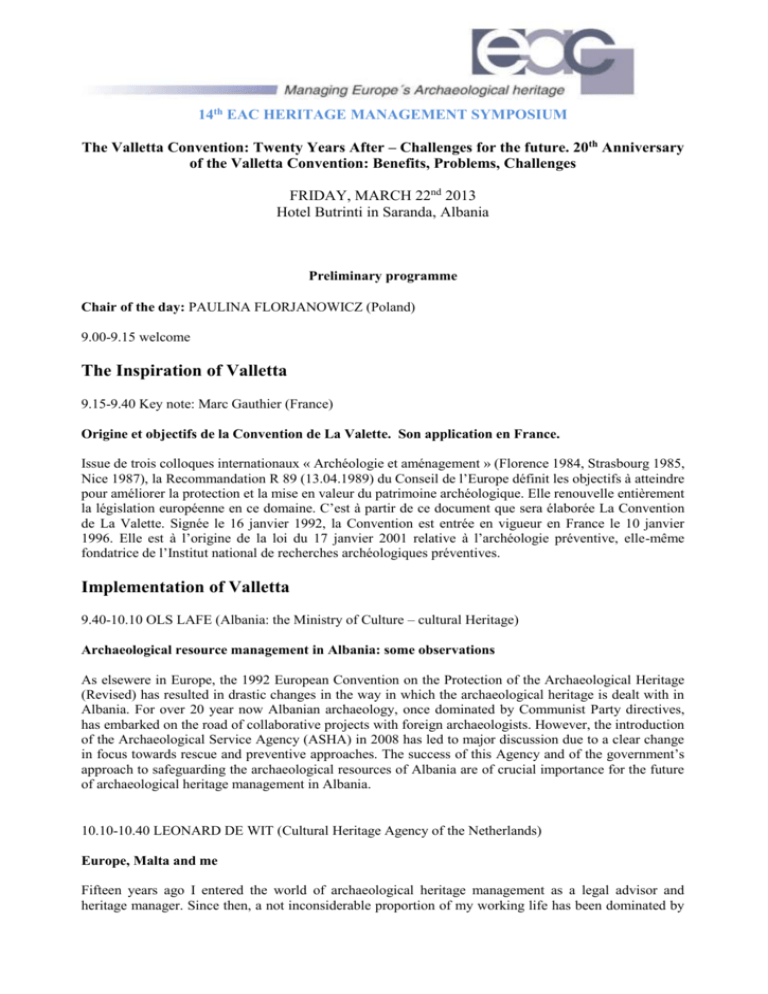
14th EAC HERITAGE MANAGEMENT SYMPOSIUM The Valletta Convention: Twenty Years After – Challenges for the future. 20th Anniversary of the Valletta Convention: Benefits, Problems, Challenges FRIDAY, MARCH 22nd 2013 Hotel Butrinti in Saranda, Albania Preliminary programme Chair of the day: PAULINA FLORJANOWICZ (Poland) 9.00-9.15 welcome The Inspiration of Valletta 9.15-9.40 Key note: Marc Gauthier (France) Origine et objectifs de la Convention de La Valette. Son application en France. Issue de trois colloques internationaux « Archéologie et aménagement » (Florence 1984, Strasbourg 1985, Nice 1987), la Recommandation R 89 (13.04.1989) du Conseil de l’Europe définit les objectifs à atteindre pour améliorer la protection et la mise en valeur du patrimoine archéologique. Elle renouvelle entièrement la législation européenne en ce domaine. C’est à partir de ce document que sera élaborée La Convention de La Valette. Signée le 16 janvier 1992, la Convention est entrée en vigueur en France le 10 janvier 1996. Elle est à l’origine de la loi du 17 janvier 2001 relative à l’archéologie préventive, elle-même fondatrice de l’Institut national de recherches archéologiques préventives. Implementation of Valletta 9.40-10.10 OLS LAFE (Albania: the Ministry of Culture – cultural Heritage) Archaeological resource management in Albania: some observations As elsewere in Europe, the 1992 European Convention on the Protection of the Archaeological Heritage (Revised) has resulted in drastic changes in the way in which the archaeological heritage is dealt with in Albania. For over 20 year now Albanian archaeology, once dominated by Communist Party directives, has embarked on the road of collaborative projects with foreign archaeologists. However, the introduction of the Archaeological Service Agency (ASHA) in 2008 has led to major discussion due to a clear change in focus towards rescue and preventive approaches. The success of this Agency and of the government’s approach to safeguarding the archaeological resources of Albania are of crucial importance for the future of archaeological heritage management in Albania. 10.10-10.40 LEONARD DE WIT (Cultural Heritage Agency of the Netherlands) Europe, Malta and me Fifteen years ago I entered the world of archaeological heritage management as a legal advisor and heritage manager. Since then, a not inconsiderable proportion of my working life has been dominated by the Valletta Convention. In the Netherlands, we generally refer to it as the Malta Convention, or simply ‘Malta’. Indeed, ‘Malta’ has become almost synonymous with ‘archaeology’. The implementation of the Convention has been a lengthy process because it meant us having to champion a cause that attracted relatively little public interest in a world of real estate interests, infrastructure, land politics and spatial planning at local and central level. The struggle to enshrine the principles of the Convention and ensure all those involved complied with them will be familiar to many archaeological heritage managers. My contribution will reflect on our success in using the Convention to ensure things were done in the right way. But we must not be entirely uncritical. All that glisters is not gold. The Netherlands conducted a thorough evaluation of its rules governing archaeology in 2012, and found that we cannot afford to rest on our laurels. We must continue to work hard to improve the system further. But this cannot be achieved solely at the national level; improvements must also come about through European collaboration. 10.55 – 11.25 Coffee break Issues – to improve the professional performance and to achieve greater acceptance 11.25 -11.45 JAN MAŘÍK (Institute of Archaeology of Academy of Sciences of the Czech Republic, Prague, v. v. i.), ANDREA FENÍKOVÁ & FILIP JAŠŠO (The Monuments Board of the Slovak Republic) Management of Archaeological Excavations their Control in Czech and Slovak Republic On January 1st 1993 the former Czechoslovakia split into two new independent states – the Czech Republic and the Slovak Republic. In regard to conservation of archaeological heritage, both states started from the same position. The carrying out of archaeological excavations was regulated by the same law and professional supervision of archaeological field work was conducted by scientific institutions established by the state – in each caste the Institutes of Archaeology of the Academy of Sciences While in the Czech Republic this system has been maintained with only small changes, a completely new structure for the Monuments’ Board has been established in the Slovak Republic with state officials serving as supervision authorities. The paper will concentrate on comparison of both systems and attempt to draw perspectives regarding further development. 11.45-12.05 CHRISTOPHER PRESCOTT (University of Oslo, Norway) Rising to the challenge? Research-based training in contexts of diversification and globalization The last twenty years has seen a massive transformation of the role and context of training archaeologists. From the training of a few research specialists geared towards academic careers within largely national frameworks, contemporary training should ideally meet the needs of a highly diverse demands of a transnational labor market largely outside university faculties, team-based research outside university faculties, ambitions of a diverse student body, and the needs of an expanding heritage sector. Not only are the tasks allotted the newly trained archaeologists increasingly diversified, the societal context is evolving. Mention here could be made of factors like demographic trends, political agendas, globalization and the changing role of the nation state, technology and the potential of modern research, privatization and pressure on the humanities in today’s economic and political climate. In this situation, training is drawn between various and sometimes conflicting interests in instrumental (and often superficial) competences versus in-depth disciplinary competence. 12.05-12.25 DAVID BIBBY (Landesamt für Denkmalpflege Baden Württemberg, Germany and co-chair of the EAC Archives Working Party) ARCHES (Archaeological Resources in Cultural Heritage. A European Standard) Since 2007 the Archaeological Archives Working party of the EAC has been researching the problems of archaeological archiving with a view to the production of a European Core Standard for archaeological archiving as well as regionally tailored applied standards for practical guidance. This activity has resulted in the EU co-funded project ARCHES (Archaeological Resources in Cultural Heritage. A European Standard), whose mission statement is: “to agree a European standard that will benefit cultural heritage practice and management in Europe and to produce a best practice manual and twinned web presence for the creation, compilation, transfer and curation of the products of European archaeology.“ The project kicked off in June 2011 and is planned to continue until May 2014. This is a progress report as well as a glance at the possible positive long term results of the project for European archaeological archiving. 12.25-12.45 BRIAN AYERS (Butrint Foundation England/Albania) Research, historic assets and the public – the example of Butrint The historic environment is a complex construct, understanding of which changes continuously with research, an activity which leads to enhanced care and conservation. Communication of the need for this research, through presentation to the public of heritage assets, must therefore enhance awareness of the processes of care as well as information concerning the asset itself. Further, ‘ownership’ by the public must be encouraged in order to foster the benefits to the wider community of effective heritage conservation. Such engagement with the public helps to build support for future research – the heritage ‘virtuous circle’. This paper will explore the complex asset that is Butrint in southern Albania, its potential for enhancing community identity and the local economy, and the role of research in developing public engagement. 12.45- 13.05 representative of the EAC Underwater Cultural Heritage Working Group 13.05-13.25 discussion chaired by ADRIAN OLIVIER (England) 13.25 – 14.25 Lunch Changing Circumstances 14.25 -14.45 JØRGEN WESTPHAL & DORTE VELEN CHRISTENSEN ( Danish Agency for Culture. Denmark) Conservation Principles – a necessary link between the Valetta Convention, national legislation and heritage management. Danish legislation adopted and implemented the Valetta Convention through a revision of the so-called Museum Act in 2002 – a single law defining the roles and obligations of the parties involved (i.e. the central government body, regional museums, owners of monuments and developers) as well as the restrictions on activities relating to monuments. A decade has passed since 2002, and the Act has yielded many benefits in regard to the preservation of the archaeological heritage. Both the Valetta Convention and the Museum Act, however, are frameworks that fail to provide guidance for decision making and prioritization on a detailed level. In 2011 this shortcoming led the Heritage Agency of Denmark to establish a set of principles for the conservation of both the archaeological and the architectural heritage. In mid-2012 the Conservation Principles were published and are now being implemented in daily heritage management. 14.45-15.05 MICHAEL LAUENBORG (Danish Agency for Culture, Denmark) Archeology as an integrated part of physical planning and management. In relation to towns, landscapes and cultural heritage. Today we have a focus on the values resting in the cultural heritage which are, important in relation to tourism and development and in relation to where human settlements are located. There is a clear need for cooperation between architects, landscape architects, historians and archeologists to optimize this potential. The triangle between the Valetta convention, the Florence Convention and the Faro convention is important in relation to how to understand, protect and disseminate knowledge and appreciation of landscape and cultural heritage. Understanding and cooperation between the cultural heritage sector, the planning sector and politicians are very essential to reach this goal. Archaeologists have a new role to play in this context where excavations are less important and awareness is more important. 15.05-15.25 KATALIN WOLLAK (National Office of Cultural Heritage, Hungary) Lessons to be learned – the impact of recession on archaeological heritage management Within the framework of the Archaeology in Contemporary Europe project a publication was launched in 2010 with the title Archaeology and the global economic crisis - Multiple impacts, possible solutions. The papers examined the concrete effects of the recession in 9 countries on research funding, professional employment and training and conservation / public outreach. A few papers touched on the influence the recession has had on heritage management policies and legislation. Among the direct effects we can see are job losses in public and private sector, a diminishing number of private firms, merging of institutions, decreasing sources and funding opportunities. These are due partly to the declining number of the developments and partly to the reduction in public resources. These changes happened in the different European countries after a 15-25 year period of intensive archaeological activity. This period which could be considered to have been the golden age of archaeology – producing enormous quantity of archaeological material, though without proper, adequate societal exploitation. As we face the fifth year of the crisis, this paper tries to explore the secondary effects as well and the possible reasons for decreasing support from decision makers and politicians. Parallel with this it is worth considering what kind of problem solving alternatives are being applied, how the different agencies elaborate new ways of working and how they are seeking to work better in the environment in which they find themselves. 15.40 – 16.10 Coffee break Future Developments 16.10-16.30 ERIKA PIELER ( Federal Ministry for Education, Arts and Culture, Department for Cultural Property Protection. Austria 20 years after – why Valetta is still worth ratifying! Heritage protection in Austria has a long history and archaeology was included from the very beginning. However, the Valetta Convention of 1992 has not yet been ratified. Twenty years on from the drafting of the Valetta Convention, Austria is currently preparing to take the necessary steps in order to fill this gap and to be part of a wider European community. Although Austria meets most of the standards set out in this convention, we believe that ratifying the Valetta Convention would give a positive momentum to our national heritage policy. The presentation will therefore deal with the process of ratification and will analyze existing standards as well as obstacles and challenges concerning implementation. Since Austria intends to ratify the Faro Convention too, the presentation will conclude with an outlook as to how Faro might support the Valetta principles. 16.30- 16.50 BIRGITTA JOHANSEN (Swedish National Heritage Board, Sweden) & MATS MOGREN (County Administrative Board (County administration in Skåne, Malmö, Sweden) 'Valetta and beyond - ideas and practices in Sweden'. 16.50 -17.20 representative of the Council of Europe – to be confirmed later 17.20 – 17.40 representative of the European Union – to be confirmed later Conclusion / afterword 17.55- 18.15 WILLEM J.H.WILLEMS (University of Leiden, the Netherlands) Malta: The Good, the Bad and the Ugly, by the last man standing As the last member of the Council of Europe's committee of Experts for the Archaeological Heritage that is still active in the field, I could not resist the temptation of the title. There can be no doubt that the adoption of the revised European Convention on the Protection of the Archaeological Heritage has changed archaeology - and not just in Europe but globally. It has changed the discipline in ways that are irreversible and it has helped to change archaeology from an ivory tower pastime still wearing the stigmata of ideological abuse and naive interpretations into a self-conscious discipline that is embedded and socially relevant. It may be less useful to investigate if the original aims of the Council of Europe or its committee of experts, or its cultural heritage division, have been achieved. I would like to look at some of the consequences of what has happened, and hopefully interact with comments from previous speakers. Such consequences need not be inherently good or bad. What can be good for a government bureaucrat charged with cultural heritage management may be less appealing to an academic archaeologist interested in developing critical and significant interpretations of the past. And indeed, what is Good in one context can be very Ugly in another. A prime example is the 'preservation in situ' dogma, which has come to dominate much of European and western archaeology in general. Even in Europe it is evident that much is to be gained from a more flexible approach, but in third world contexts its effects can be completely disastrous. As the famous Dutch philosopher Johan Cruijff expressed it once: every advantage has a disadvantage, and it is worthwhile to be aware of these.

